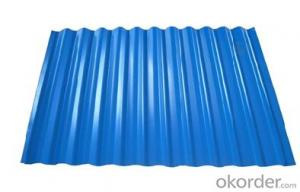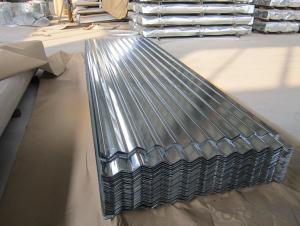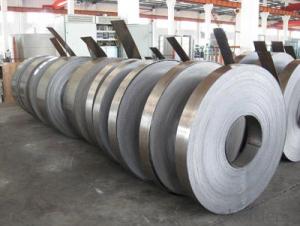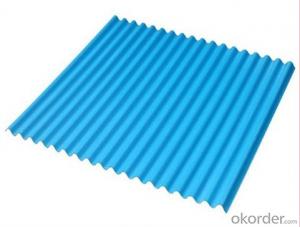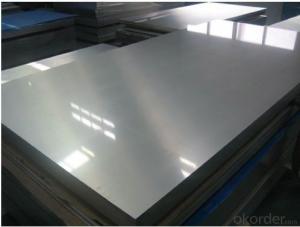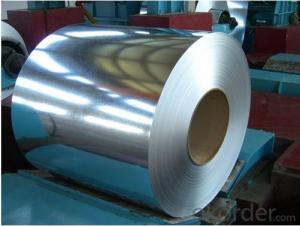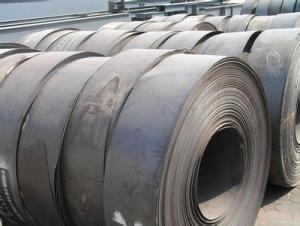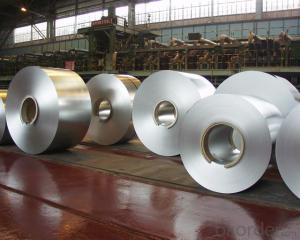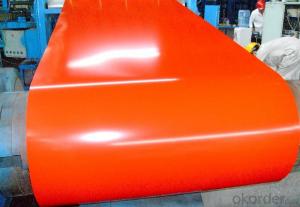Premium Colorful Corrugated GI Galvanized Metal Sheet
- Loading Port:
- Tianjin
- Payment Terms:
- TT OR LC
- Min Order Qty:
- 50 m.t.
- Supply Capability:
- 2000 m.t./month
OKorder Service Pledge
OKorder Financial Service
You Might Also Like
Item specifice
Product Brief Introduction
Premium Colorful Corrugated GI Galvanized Metal Sheet
Galvanized Corrugated Steel Roofing Sheet is formed by cold roll machine, using galvanized steel sheet or aluminum steel as the base material .Galvanized corrugated steel roofing sheet is featured with easy installation ,high strength ,more economic .( low cost )
Product Features
.Outlook Beautiful and novel, rich colors, flexible combination, can be used in different buildingto express special original architectural styles in life.
.Surface have been treated as galvanized and color coated.so it can anti-rain,anti- fire,anti-quake,So it has a long term life as 20-30 year and color just not fade.
. Light weight: easy to transport the material,short the time to finish the building,reduce worker's hard work,save much time and energy for human beings.
.Smooth surface treatment,the dust will be easy taken off by the rain.
. Environmental material,can be used many times,will do no hard to the our environment.
Product Specification
.Thickness:0.13mm to 0.8mm
.Length: 1m to 11.8m.
. Color: navy blue,white grey and any RAL colors.
. Certification: ISO9001:2000.
.Material : cold rolled galvanized steel coil.
. Standard: JIS,DX51D,SGCC,Q235. A653
. advantage: waterproof,light weight, high strength,best price.
. HS code: 7210700000
Packing Information (For 27.5 Tons heavy 20’Fcl)
. water proof paper packing in side
. plastic film Packing in middle
. steel sheet Packing out side
.several steel strip packing to fix the packing
Production Line & Package
FAQ
1. how many wave for per pcs
—— some wave is 8 ,same wave is 9 ,save wave is 11 ,it is up to your request
2. What is the MOQ for this products ?
—— Normally the MOQ is 25mt per size and per color .

- Q:How are steel strips processed for load-bearing capacity?
- Steel strips are processed for load-bearing capacity through a series of manufacturing and treatment processes. The first step in enhancing load-bearing capacity is the selection of the appropriate grade of steel. Different grades of steel have varying mechanical properties, such as yield strength and tensile strength, which directly impact load-bearing capacity. Higher strength grades, such as high-strength low-alloy (HSLA) or advanced high-strength steel (AHSS), are typically chosen for applications requiring greater load-bearing capacity. Once the steel grade is determined, the steel strips undergo a series of manufacturing processes. The strips are usually hot-rolled or cold-rolled to achieve the desired thickness and shape. Hot-rolling involves heating the steel above its recrystallization temperature and passing it through a series of rollers to reduce thickness and shape it into a strip. Cold-rolling, on the other hand, involves passing the steel through rollers at room temperature, resulting in a smoother finish and tighter tolerances. After the initial rolling process, the steel strips may undergo further treatments to enhance their load-bearing capacity. One common treatment is heat treatment, which involves heating the steel to a specific temperature and then rapidly cooling it to alter its microstructure. This process can increase the strength and hardness of the steel, improving its load-bearing capacity. Other treatments may include surface coatings or galvanization to protect the steel from corrosion, which can weaken its load-bearing capacity over time. Coatings such as zinc or epoxy can provide an extra layer of protection against environmental factors that may compromise the integrity of the steel strips. In summary, steel strips are processed for load-bearing capacity by selecting the appropriate grade of steel, followed by manufacturing processes such as hot-rolling or cold-rolling. Additional treatments like heat treatment and surface coatings may be applied to further enhance the load-bearing capacity and protect the steel from corrosion.
- Q:The relation between hot rolled strip and cold rolled coil, hot rolled strip and cold rolled strip
- Cold rolled coil (annealed): hot rolled coil obtained by pickling, cold rolling, batch annealing, flattening, and finishingThat is, the biggest difference between hot rolled coil and cold rolled coil is that the heat treatment process is different. (annealing process)Compared to the specific heat roll, the cold-rolled roll has a bright surface and a high degree of finish, but it produces more internal stress and is often annealed after cold rolling.
- Q:How are steel strips used in the textile industry?
- Steel strips are commonly used in the textile industry for various purposes such as reinforcing fabrics, providing strength and stability to garments, and creating structured elements in clothing and accessories. Additionally, they are used in textile machinery for guiding and supporting fabrics during the manufacturing process.
- Q:Can steel strips be coated with non-slip materials?
- Yes, steel strips can be coated with non-slip materials such as rubber, paint, or adhesive tapes to enhance their grip and provide a safer walking or gripping surface.
- Q:How are steel strips used in the production of agricultural implements?
- Agricultural implements rely on steel strips in various ways. Firstly, steel strips are commonly utilized to manufacture the blades of farming tools like plows, cultivators, and harrows. These blades must possess strength and durability to withstand the demanding conditions of agricultural work, and steel strips provide the necessary qualities. Furthermore, steel strips are also employed to produce essential components such as brackets. These components play a crucial role in attaching different parts of agricultural machinery together. They need to be sturdy and capable of withstanding heavy loads, and steel strips offer the requisite strength and stability. Moreover, steel strips are used to create the structural frames of agricultural implements. These frames must be rigid and able to support the weight of the machinery, while also enduring the forces and vibrations experienced during operation. Steel strips provide the necessary structural integrity and durability to ensure the long-lasting and efficient performance of the agricultural equipment. In conclusion, the strength, durability, and ability to withstand harsh farming conditions make steel strips indispensable in the production of agricultural implements. They are utilized for manufacturing blades, brackets, and structural frames, guaranteeing that the machinery is robust and capable of efficiently carrying out its intended tasks.
- Q:How are steel strips tested for coating thickness?
- Steel strips are tested for coating thickness using various methods and instruments. One of the most common methods is the magnetic induction method, also known as magnetic pull-off method. In this method, a handheld gauge with a magnetic probe is used to measure the magnetic attraction between the probe and the steel strip. The coating thickness is then calculated based on the strength of the magnetic attraction. Another commonly used method is the eddy current method. This method utilizes a handheld gauge with an eddy current probe. The probe generates an alternating magnetic field that induces eddy currents in the steel strip. By measuring the impedance of these eddy currents, the coating thickness can be determined. Ultrasonic thickness gauges are also used to test coating thickness on steel strips. These gauges emit high-frequency sound waves that penetrate the coating and reflect back from the steel strip. By measuring the time it takes for the sound waves to travel and return, the coating thickness can be calculated. In addition to these methods, there are also destructive tests that involve cutting a small section of the steel strip and measuring the coating thickness using microscopy or other specialized equipment. However, destructive tests are typically used as a last resort or for quality control purposes. Overall, the testing of coating thickness on steel strips involves a combination of non-destructive methods such as magnetic induction, eddy current, and ultrasonic testing, along with occasional destructive tests for verification and quality control.
- Q:Can steel strips be used in the manufacturing of appliances?
- Yes, steel strips can be used in the manufacturing of appliances. Steel strips are commonly used in the appliance industry due to their strength, durability, and ability to be formed into various shapes and sizes. They are used in the production of components such as panels, frames, and brackets, providing stability and structural support to appliances.
- Q:What are the cost considerations for using steel strips?
- Some of the cost considerations for using steel strips include the cost of purchasing the steel strips themselves, transportation costs, processing and fabrication costs, and any additional costs associated with surface treatments or coatings. Additionally, factors such as market demand, availability, and fluctuations in raw material prices can also impact the overall cost of using steel strips.
- Q:What are the environmental benefits of using steel strips?
- Steel strips have several environmental benefits. Firstly, steel is a highly recyclable material, which means that using steel strips promotes a circular economy and reduces the need for new steel production. This helps to conserve natural resources and reduce energy consumption. Additionally, steel is durable and long-lasting, which means that products made from steel strips have a longer lifespan, reducing the need for replacements and minimizing waste. Furthermore, steel has a low carbon footprint compared to other materials, making it a more sustainable choice. Overall, using steel strips can contribute to a more environmentally friendly and sustainable manufacturing process.
- Q:Can steel strips be used in the manufacturing of bicycles?
- Yes, steel strips can be used in the manufacturing of bicycles. Steel is a commonly used material in bicycle manufacturing due to its strength, durability, and versatility. Steel strips can be used for various bicycle components such as frames, forks, handlebars, and racks. Steel provides excellent rigidity and stability, making it suitable for various riding conditions and terrains. Additionally, steel is relatively affordable compared to other materials such as carbon fiber or aluminum, making it a popular choice for bicycles.
1. Manufacturer Overview |
|
|---|---|
| Location | |
| Year Established | |
| Annual Output Value | |
| Main Markets | |
| Company Certifications | |
2. Manufacturer Certificates |
|
|---|---|
| a) Certification Name | |
| Range | |
| Reference | |
| Validity Period | |
3. Manufacturer Capability |
|
|---|---|
| a)Trade Capacity | |
| Nearest Port | |
| Export Percentage | |
| No.of Employees in Trade Department | |
| Language Spoken: | |
| b)Factory Information | |
| Factory Size: | |
| No. of Production Lines | |
| Contract Manufacturing | |
| Product Price Range | |
Send your message to us
Premium Colorful Corrugated GI Galvanized Metal Sheet
- Loading Port:
- Tianjin
- Payment Terms:
- TT OR LC
- Min Order Qty:
- 50 m.t.
- Supply Capability:
- 2000 m.t./month
OKorder Service Pledge
OKorder Financial Service
Similar products
New products
Hot products
Hot Searches
Related keywords
